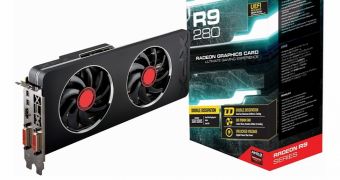The Radeon R9 280 may not be the best of AMD's video cards, but it is one of those that sell the best, because it has a better balance between affordability and performance than the ones above it. Perhaps this is why XFX made two of them.
Which is to say, XFX has formally introduced the Radeon R9 280 Double Dissipation graphics adapters, the R9 280 Double Dissipation and R9 280 Double Dissipation Black Edition.
Even from just the name it's easy to figure out what the difference between them is: one is factory-overclocked and the other isn't. Three guesses which is which.
The names are also a bit misleading though, because they might infer that only one of the newcomers has a black color theme.
Which, of course, is not true. They are both as black as they come, and that goes for both the cooler and the PCB (printed circuit board).
The cooler shroud even covers the top edge of the card, leaving space only for the CrossFireX connectors.
The only exception (not counting the metallic grey of the I/O panel) is the pair of red fan tops. The blades are black, but the coverings over the fan bearings are not.
Anyway, there are two models, as we said. The base card, R9 280 Double Dissipation, has a base GPU clock frequency of 827 MHz and a GPU Boost speed of 933 MHz.
Also, the memory (3 GB GDDR5 VRAM) functions at 5 GHz, which is pretty standard for the price point: $280 / €280. That's right, a Radeon R9 280 graphics card priced at $280 / €280. What a coincidence.
The other video card, Radeon R9 280 Double Dissipation Black Edition runs the Tahiti GPU at 1,000 MHz (all the time, no Boost at all) and the memory at 5.2 GHz. Its price is of $300 / €300.
Both adapters are otherwise the same, as dictated by the internal makeup of the graphics processing units. Thus, buyers will get 1,792 stream processors (SPs), 112 texture mapping units (TMUs), 32 raster operating units (ROPs), and a 384-bit wide GDDR5 interface.
The prices haven't been confirmed by Advanced Micro Devices yet, or by retailers, but they are the most likely right now, because the reference R9 280 ships for $279 / €279, or will ship soon enough. AMD launched it just hours ago.
Don't rush to buy them yet though. Give it a few days until all of AMD's partners unveil their R9 280 cards. Then you can make a fully informed decision.

 14 DAY TRIAL //
14 DAY TRIAL //